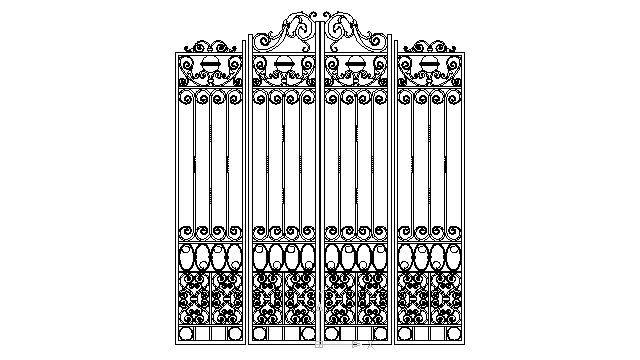

L&L Ornamental Iron, Wood & Aluminum LL Building Products, Inc.
#Ornamental iron cad Offline
The same 3D models can be leveraged by utilizing them in the development of marketing collaterals and eCatalogs to attract and engage customers through both offline and online marketing channels.Ameristar Security Products Industrial & Security Steel Fence Further through design automation of configurable products, marketing teams can quickly quote the price to the customer for their choice of configuration and can directly generate models and drawings for the manufacturing teams. Through these they can better engage customers and make them realize the details about the product they are buying. Marketing department benefits the most through these 3D CAD models.

The 3D annotated model can then be considered as a single source of truth across the product development process, providing better version control and elimination of 2D drawings from the process. It directly integrates product manufacturing information (PMI) onto the 3D model with all the GD&T information. However 2D drawings can be eliminated completely by adopting MBD approach, which shifts 3D models from design to manufacturing, very conveneintly. The model is then juggled back and forth, until it reaches to a mutually agreeable form. The process gets even more complex with the addition of GD&T (geometric dimensioning and tolerancing) information, which often leads to multiple ECOs (engineering change orders). As mentioned earlier, fabricators spend most of their time in converting 3D models to 2D manufacturing drawings, relevant to existing shop and tooling capabilities. Similar to traditional quoting practice, the actual fabrication at the shop floor occurs mostly with help of conventional 2D drawings. Modern CAD systems even allow generating quotes directly based on the information, allowing sales team to generate consistent and accurate quotes quickly. The process of quoting can be made far more efficient and accurate just by utilizing CAD models with added manufacturing and costing information.Īdvanced CAD tools allow design engineers to directly integrate material cost, nesting strategies and information about CNC cutting paths above and over the intelligent 3D CAD model. With this method, the fabricator can never ascertain the profitability based on the quote developed.

The final quote is then developed by adding cost of secondary manufacturing operations such as bending, grinding and welding and shipping costs. The drawings are required to be manually inspected for material estimation and determining the manufacturing time required.
#Ornamental iron cad manual
There are complex manual calculations involved that often lead to the possibility of inaccuracies and inconsistencies. The quoting process at almost every shop floor is a traditional one, which is based largely on engineering experiences and best guesses. This is an effort to shed light on how intelligent 3D CAD models can be utilized across all areas of business right from quoting and fabrication through marketing. Intelligent digital 3D model is therefore a key to develop accurate downstream documentation, not only for fabrication but even for suppliers, marketers and even end customers.
#Ornamental iron cad free
The need to implement this productive change is evident as machinists on an average spend more than 8 hours per week juggling with the development of manufacturing documentation.Īpart from this, couple of hours is also wasted in clarifying documentation and generating additional information to support lag free sheet metal product development. With the amount of intelligence a 3D CAD model can possess today through advancement in CAD technologies, the intelligent design data can be leveraged across the sheet metal product development process to remain more productive and profitable. His contributions are primarily focused on encouraging manufacturers and suppliers to adopt virtual product development tools to build efficient products with reduced time-to-market.įabricators are missing out a great deal of opportunity, by restricting the use of CAD models merely for the design stage. He covers CAD and CAE topics for the engineering industry. Kashyap Vyas is an Engineer at Hi-Tech CADD Services and holds a Master’s degree in Thermal Engineering with several research papers to his credit.


 0 kommentar(er)
0 kommentar(er)
